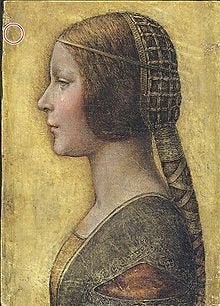
Most columnists are pretty good at walking to the fridge. We're good at eating biscuits. We're good at putting on kettles. We're good at anything, really, that takes us away from the blank screen and ticking clock. But even those of us who wander to the kettle even when our current cup of tea is scalding hot can't help but be impressed by a man who took 25 years to meet a deadline. A man called Leonardo da Vinci.
Leonardo loved making lists. He made lists of clothes he should buy, and books he should borrow. He never discovered the joy of quickly checking something on Wikipedia and finding himself sucked into a wild goose chase a bit like the one that made him a bestseller. He never got the chance to tap his name into Google and see whether his 42,600,000 mentions had gone up to 42,600,001. But he could doodle, and he could scribble, and he could, when he was meant to be doing something else, design flying machines and tanks, and he could, when he was meant to be doing something else, knock off a nice piece of music or a poem. He was very, very interested in everything except the thing he was being paid to do. Which was, at least most of the time, to paint.
You'd have thought that someone who seemed to spend most of his time looking for excuses not to paint, and who finished only about 15 paintings in his whole lifetime, might not be all that good at it. You might worry that what they came up with would be a bit slapdash, the kind of thing you know is art only because the artist who made it, and the people who buy it, say so. But you would, of course, be wrong.
Even the ventricles are a thrill. You're dying to see the paintings, because the press has gone on and on and on about them, and because people are queueing for hours to see them, and because the private view of them was seen as such a big event that it was screened live in cinemas across the country, but actually when you see a sketch of a cross-section of a man's head, and the "ventricles" of the brain, which is the first thing you do see when you walk into the exhibition on Leonardo as a "painter at the court of Milan" at the National Gallery, what you feel is the kind of thing you felt when you were a child ripping open a Christmas stocking. You feel it when you see other sketches, too: of hands, and of cloth hanging from an arm, and of dog's paws, and a bear's head, and a toddler's torso. What you feel is the thing that Wordsworth said people do sometimes feel when they look at something beautiful. What you feel is that you can, at least for a moment, "see into the life of things".
And when you do go and look at the paintings, and particularly when you look at the painting of the "Lady with an Ermine," who isn't actually a lady, but a 15 or 16-year-old girl, what you feel is that you might, if you don't get a grip, start crying. When you look at her eyes, and her neck, and her skin, and when you see the light that seems to be shining out of her, and when you see an elderly man push his elderly wife's wheelchair closer to the painting, so that they can both get closer to a girl who's as beautiful as a girl can be, and closer, perhaps, to a memory of youth, what you feel is that this must be what some people feel when they think they're in the presence of God.
What you feel, when you see these paintings, is that the man who has painted them has managed, like almost no one else, to capture something you're not even sure you believe in, which you could call the human soul. You feel that what he has done is a kind of miracle, and maybe the nearest that human beings will ever get to the miracle, of salvation through a virgin birth, he paints.
But when you see the sketches, and the studies, and the measurements, and the notes, you see that what we call "genius" isn't something that just comes through a spark, like the spark you almost think you see in his rival's painted ceiling in the Sistine Chapel, of God creating man. It's something that comes, if it comes, which it hardly ever does, through thinking, and working, and dreaming, and trying, and trying, and trying, and trying, and trying again.
"When a work stands equal to one's judgement," said Leonardo, in one of his many notebooks, "it is a bad sign for the judgement." He thought, like all great artists, that nothing he did was ever good enough. He knew that people who thought their work was good enough were nearly always wrong.
We need our Leonardos. We need to be reminded, and particularly when the country he lived in, and the continent we live in, appear to be on the brink of disaster, that while human beings are very good at messing things up, they can also, sometimes, do things well. We need to know that doing things well isn't always something we should leave to other people.
Leonardo would have agreed with another man we could call a genius, a man who lived, for a while, but 500 years later, not far from Milan. "Ever tried," said Samuel Beckett. "Ever failed. No matter. Try again. Fail again. Fail better."